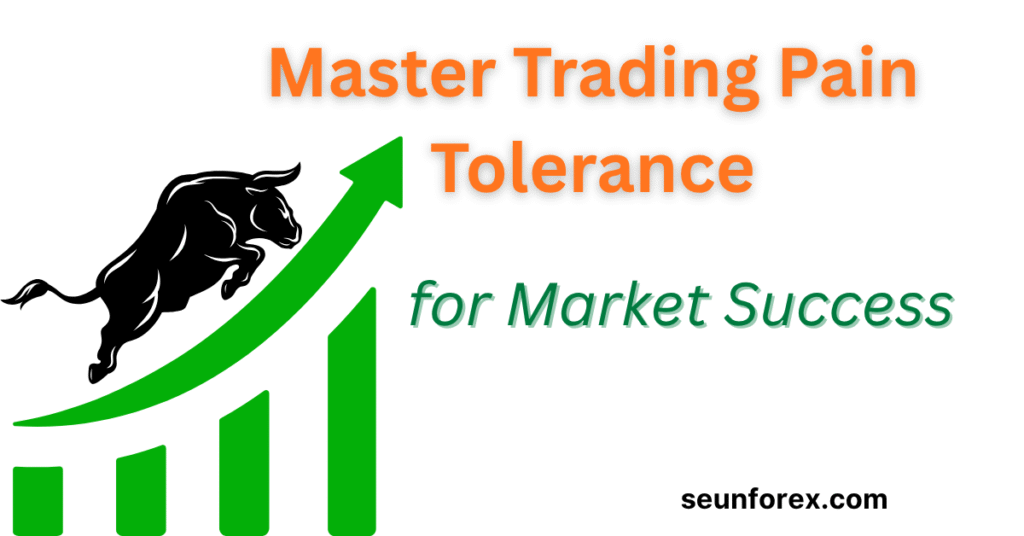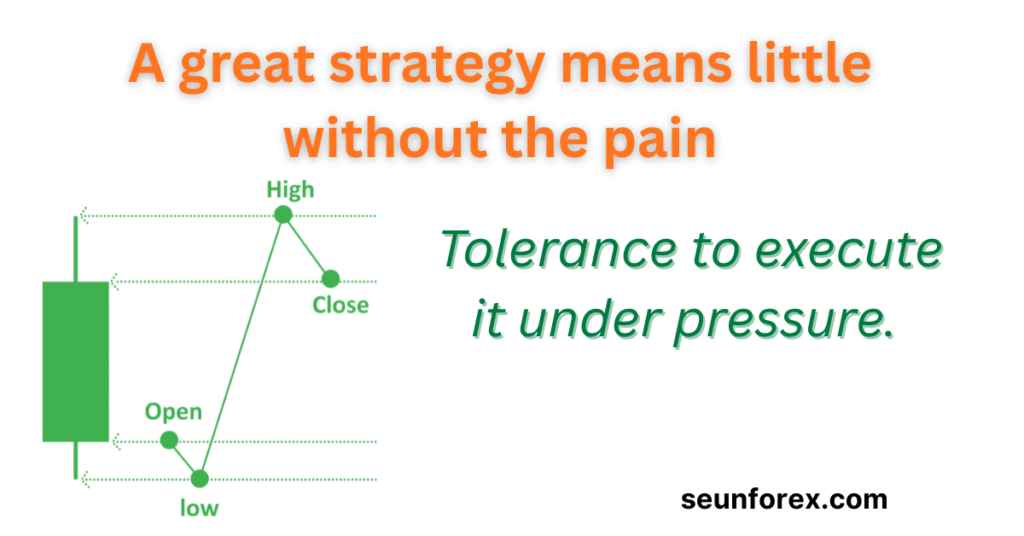
A deep dive into why enduring losses, volatility, and uncertainty consistently matters more than the strategy itself—and how to systematically build this mental edge.
Great traders are like deep-sea divers. At the surface, everyone sees the same blue waves: charts move, signals flash, and news headlines scream. The edge isn’t visible there. It’s hundreds of trades below, where your mind encounters stress, fear, and uncertainty—and where trading pain tolerance reshapes how you react.
Trading pain tolerance isn’t just emotional grit; it’s a measurable skill you can develop, much like mastering trading psychology techniques. Understanding why emotional control in trading and enduring discomfort matter more than any strategy will permanently elevate your trader discipline and resilience. By learning to manage drawdowns and act deliberately under stress, you reinforce a mindset that gives you a long-term edge in the markets.
🎯 What Is Pain Tolerance in Trading?
Trading pain tolerance is the capacity to withstand financial, emotional, and cognitive discomfort without making impulsive or irrational decisions. In trading, this typically includes:
- Drawdowns: Accepting that losses are part of the process without deviating from your plan, reinforcing trader discipline and resilience.
- Volatility: Maintaining composure when markets swing wildly, a key aspect of emotional control in trading.
- Uncertainty: Acting with discipline when outcomes are probabilistic, not certain, reflecting strong trading psychology techniques.
- Information overload: Not panicking when news, rumors, or social media flood your decision-making process.
- Self-doubt and fear of missing out (FOMO): Recognizing impulses to chase winners or avoid losses prematurely.
High trading pain tolerance allows traders to execute strategies consistently, while low tolerance leads to early exits, revenge trading, and emotional mistakes.
Historical Example: Ed Seykota famously wrote: “The trend is your friend until the end when it bends.” His point wasn’t the strategy itself—it was enduring discomfort with strong trader discipline and resilience until the signal proved otherwise. Similarly, Paul Tudor Jones emphasized that “Every day you have to fight the human tendency to panic,” highlighting that emotional control in trading and patience are often more critical than any mechanical approach.hlighting that resilience and patience are more critical than any mechanical approach.
🧩 Why Pain Tolerance Beats Strategy (The Science Bit)
Like building muscle, your mental endurance strengthens with deliberate stress exposure. Here’s what happens when you cultivate trading pain tolerance:
1. Neural Wiring for Stress Management
- Each time you survive a loss without panic, your brain encodes a new reference for handling future stress.
- After hundreds of trades under discomfort, your decisions shift from reactive to deliberate.
- Neuroplasticity works in your favor: repeated exposure to stress rewires your prefrontal cortex, improving impulse control and decision-making under pressure.
2. Bias Reduction
- Pain-tolerant traders are less likely to suffer from loss aversion, recency bias, or overconfidence.
- Your edge comes from seeing setups clearly, not clouded by emotional noise.
- Over time, traders learn that losses are data, not personal failures, and begin treating losing streaks as valuable information rather than threats.
3. Execution Mastery
- Most strategies fail not because they are poor but because traders exit prematurely or overtrade.
- Tolerating the psychological pain of drawdowns ensures strategy execution remains intact.
- Consider a trader with a high-probability swing setup: without the ability to endure temporary drawdowns, even perfect setups can result in losses.
4. Decision Clarity Under Uncertainty
- Pain-tolerant traders don’t chase “sure things.”
- They act probabilistically, executing trades when the odds favor them, even amid discomfort.
- This probabilistic mindset separates professional traders from hobbyists who react emotionally to every market twitch.
🧪 Step-by-Step Pain Tolerance Deep Dive
You can systematically develop pain tolerance as you would a trading strategy. Here’s how:
Step 1: Identify the Pain Points
- Track your emotional reactions to drawdowns.
- Identify triggers: market reversals, gaps, or unexpected news.
- Example: Your standard 1% stop loss triggers anxiety—note this.
Pro Tip: Use a color-coded diary or spreadsheet to visualize triggers and severity. Red flags for panic, yellow for mild stress, green for calm execution.
Step 2: Quantify Your Discomfort
- Log losses and gains, but also log emotional scores from 1–10.
- Chart patterns: Which trades cause panic vs. calm?
- Pattern recognition applies to psychology as much as price action.
Example Table: Emotional Trade Journal
| Trade | Setup | Drawdown % | Emotional Score | Action Taken | Outcome | Notes |
|---|---|---|---|---|---|---|
| EUR/USD | Breakout | 3% | 8 | Exited early | -1% | Panic triggered by news gap |
| AAPL | Swing | 2% | 4 | Held | +3% | Felt anxious but followed plan |
Step 3: Controlled Exposure
- Start small: accept minor losses on demo or small live accounts.
- Gradually increase exposure to simulate larger drawdowns.
- Purpose: rewire the brain to perceive losses as data, not disaster.
Exercise: Schedule “stress trades” where you deliberately hold through a 2–3% drawdown without changing the strategy. Record physiological reactions—heartbeat, tension, eye movement, and emotional state.
Step 4: Develop Coping Strategies
- Journaling: record not just trades, but emotions.
- Breathing techniques: box breathing or 4-7-8 breathing during high-volatility sessions.
- Visualization: mentally rehearse scenarios of losses, volatility, and reversals.
- Meditation & mindfulness: a daily 10-minute practice can lower baseline stress and improve reaction times.
Step 5: Create a “Pain Edge” Rulebook
- Define clear rules for when to act and when to wait.
- Tie position sizing and stop-loss placement to your emotional tolerance, not just strategy metrics.
- Example: “I can hold through 5% drawdown without adjusting my strategy. Beyond that, I reassess based on objective criteria.”
Advanced Tip: Use a tiered pain tolerance scale:
- Tier 1: Mild discomfort (0–2% drawdown) — execute as planned.
- Tier 2: Moderate discomfort (3–5% drawdown) — reduce size, double-check rules.
- Tier 3: High discomfort (5%+) — pause, reflect, adjust only based on data.
🏆 Case Study: Pain Tolerance vs Strategy Execution

Let’s examine a hypothetical trader, Alex, who uses a technically solid breakout strategy:
- Strategy: Breakout above 20-day high with 2× volume.
- Scenario: Market drops 4% immediately after entry.
- Low tolerance reaction: Panic exit, losing potential 10% gain.
- High tolerance reaction: Hold through volatility, trade eventually hits target +15%.
Lesson: Alex’s strategy wasn’t flawed—the differentiator was mental resilience under pain.
Extended Example: Imagine Alex faced a 10-trade losing streak on this strategy. Without pain tolerance, he might abandon the plan entirely, missing subsequent profitable trades. With tolerance training, he endures the psychological stress, ensuring consistent application of the strategy until favorable conditions resume.
🧰 Templates for Practicing Pain Tolerance
Trade Window Template
| Setup Type | Lead-In Condition | Emotional Response Rating | Action Taken | Outcome | Notes |
|---|---|---|---|---|---|
| Momentum | Drawdown 3%, volatility spike | 7 | Held | +4% | Managed stress using breathing |
| Swing | Overnight gap | 9 | Adjusted size | +2% | Learned gap resistance pattern |
After 50–100 trades, aggregate patterns to identify your psychological sweet spot.
Pro Tip: Compare emotional scores with outcomes to discover which stress levels correlate with successful execution.
🧪 Two Deep-Dive Projects for Pain Tolerance
1) The Short-Term Drawdown Bootcamp
Goal: Learn to tolerate 2–5% drawdowns without deviation.
How to do it:
- Pick 20–30 trades on demo accounts.
- Record emotional score at entry, mid-trade, and exit.
- Force yourself to follow your strategy strictly.
- Track when emotional spikes occur.
Expected Outcome: Minor drawdowns stop triggering impulsive behavior, building confidence to hold through future volatility.
Exercise: After each session, summarize key stress points and coping success in a structured table.
2) The Long-Term Swing Exposure
Goal: Build endurance for extended periods of unrealized losses.
How to do it:
- Simulate 1–3 month trades on demo or micro accounts.
- Document emotions, news reactions, and drawdown thresholds.
- Compare trades where patience was maintained vs. early exits.
Expected Outcome: You’ll learn which setups you can endure longer, improving risk-reward execution.
Bonus Exercise: Overlay your emotional score with moving averages and volatility to see patterns between market conditions and stress levels.
🧩 Why Strategy Alone Fails Without Pain Tolerance
Even the most profitable strategies require psychological endurance:
- High probability setups fail: Markets are probabilistic; losing streaks are inevitable.
- Overconfidence traps: Winning streaks make traders abandon rules.
- Drawdown shock: Low tolerance leads to premature exits.
- Information fatigue: News, rumors, and chatter can lead to impulsive decisions without resilience.
Key Insight: A mediocre strategy executed with high mental resilience often outperforms a brilliant strategy executed emotionally.
🧭 Building Your Pain Tolerance Workflow (Step-by-Step)
- Pick one pain-inducing setup
- Focus on scenarios that cause stress: overnight gaps, news events, volatile sessions.
- Record your reactions
- Use your trade window template for objective journaling.
- Aggregate data
- Analyze 50–100 trades to extract patterns.
- Create numeric rules
- “I can hold through X% drawdown for this setup.”
- Forward test
- Apply rules to small real trades, adjust as necessary.
- Iterate
- Repeated exposure rewires your mental response and strengthens your edge.
Certainly! Here’s the revised section with internal and external links, along with explanations to encourage readers to explore both resources:
🧨 Common Mistakes in Pain Tolerance Training
- Ignoring emotions entirely
Overlooking emotional responses can lead to undisciplined trading behaviors. - Confusing stubbornness with resilience
Persisting in a losing position due to sheer willpower, rather than adherence to a well-thought-out plan, can be detrimental. - Not tracking progress
Failing to monitor emotional reactions and trading outcomes hinders improvement. - Treating success as proof instead of evaluating repeated stress endurance
A single profitable trade doesn’t validate a strategy; consistent performance under stress does. - Focusing only on strategy optimization while neglecting psychological calibration
A robust trading strategy is ineffective if the trader’s mindset isn’t aligned with its demands.
✅ Closing Checklist: Build Your Pain Edge
- Identify triggers and quantify discomfort
Recognize situations that cause emotional distress and assess their impact on decision-making. - Expose yourself incrementally to controlled stress
Gradually increase exposure to challenging trading scenarios to build resilience. - Maintain a structured journal
Document trades, emotional responses, and outcomes to identify patterns and areas for improvement. - Aggregate data and extract patterns
Analyze journal entries to understand recurring emotional triggers and their effects on trading decisions. - Align position sizing and stop losses to your mental edge
Adjust risk parameters to match your psychological tolerance, ensuring decisions remain objective. - Iterate and refine
Continuously review and adjust strategies based on insights gained from journaling and analysis.
For a deeper understanding of trading psychology and emotional control, consider exploring the following resources:
- Master Your Trading Risk Tolerance
This article delves into the psychological aspects of trading risk tolerance, emphasizing the importance of self-awareness and emotional discipline in trading. - Trading Psychology: What It Is and Importance
Investopedia’s article provides insights into how emotions and cognitive biases influence trading decisions and performance.
By engaging with these resources, you’ll gain valuable perspectives on managing emotions and enhancing your trading mindset. Understanding and improving your psychological approach to trading is as crucial as refining your trading strategies.